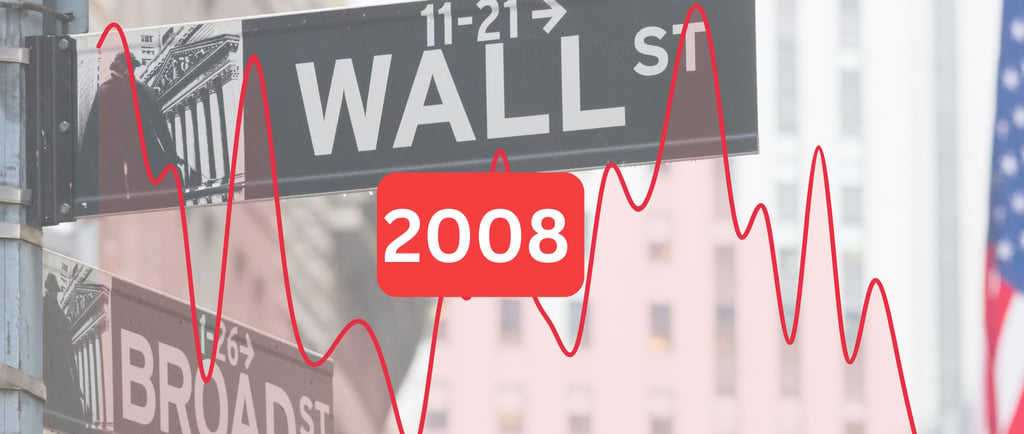The 2008 Financial Crisis. What Happened?


Introduction
The 2008 financial crisis, also known as the Global Financial Crisis (GFC), was the worst economic disaster since the Great Depression of 1929. It started in the United States but quickly spread to the entire world, causing widespread panic, massive job losses, bank failures, and economic recessions across many countries. In this blog, we'll explain what led to the crisis, how it unfolded, and the lessons it taught us—all in simple, easy-to-understand language.
How It All Began: The Housing Bubble
To understand the 2008 financial crisis, we need to start with the U.S. housing market. In the early 2000s, housing prices were rising fast. People believed that buying a house was a guaranteed way to make money, so more and more people took out loans to buy homes, even if they couldn't really afford them.
Banks, on the other hand, were giving out mortgages (home loans) to almost anyone. These risky loans were called "subprime mortgages." Subprime means that the borrower has a low credit score and is more likely to default (fail to repay the loan). But banks didn’t worry too much because they thought housing prices would keep going up, so even if someone couldn't pay, the bank could sell the house and still make a profit.
The Role of Wall Street and Mortgage-Backed Securities (MBS)
Wall Street banks took these mortgages and bundled them into financial products called mortgage-backed securities (MBS). They then sold these to investors like pension funds, insurance companies, and other banks around the world. These MBS looked like safe investments because they were backed by real estate. Credit rating agencies even gave them high ratings (like AAA), even though they were made up of risky subprime loans.
As long as housing prices kept going up, this system worked. Banks made money, investors made money, and homeowners thought they were building wealth. But underneath the surface, the system was built on a shaky foundation.
The Bubble Bursts
By 2006, housing prices started to slow down. Then they began to fall. As prices dropped, people who bought homes with subprime loans couldn't refinance or sell their homes. Many defaulted on their loans, leading to a rise in foreclosures.
This had a ripple effect. The mortgage-backed securities that investors bought started to lose value. Suddenly, these investments that were once seen as safe turned toxic. Banks and investors holding these assets started to suffer huge losses.
The Domino Effect: Lehman Brothers and Global Panic
In September 2008, Lehman Brothers, one of the largest investment banks in the U.S., declared bankruptcy. This sent a shockwave through the global financial system. Other banks and financial institutions were scared to lend money to each other because they didn't know who might fail next. This caused a credit freeze.
Without credit, businesses couldn’t operate normally. They couldn't borrow money to buy supplies, pay workers, or invest. This led to layoffs, bankruptcies, and a sharp drop in consumer spending. The economy fell into a deep recession.
Government and Central Bank Interventions
The U.S. government and the Federal Reserve (the central bank) had to step in with emergency measures to prevent a total collapse of the financial system. Here’s what they did:
Bailouts: The government gave money to struggling banks and car companies to keep them from going bankrupt. This was very controversial, but it was done to prevent even bigger problems.
TARP (Troubled Asset Relief Program): The U.S. Congress approved $700 billion to buy toxic assets from banks to clean up their balance sheets.
Quantitative Easing: The Federal Reserve started buying large amounts of government bonds and mortgage-backed securities to inject money into the economy.
Lowering Interest Rates: The Fed slashed interest rates to near zero to encourage borrowing and investing.
These steps helped stabilize the financial system, but the damage had already been done. The economy took years to recover.
Impact Around the World
Because the global financial system is interconnected, the crisis didn't stay in the U.S. Banks and investors in Europe, Asia, and other parts of the world also held toxic mortgage-backed securities. Many foreign banks suffered huge losses.
Countries like Iceland saw their entire banking systems collapse. Europe entered a recession. In developing countries, exports dropped because consumers in the U.S. and Europe were not spending. Global unemployment rose, and millions of people fell into poverty.
The Human Cost
The numbers were staggering:
Over 8 million jobs were lost in the U.S.
Unemployment in some countries went above 10%.
Millions of homes were foreclosed.
Families lost their life savings and retirement funds.
People suffered emotionally and mentally. Stress, depression, and anxiety became common as people struggled to find jobs, keep their homes, and pay their bills.
What We Learned: Key Lessons from the 2008 Crisis
Too Much Risk Is Dangerous Financial institutions were taking on too much risk without fully understanding the consequences. They were focused on short-term profits rather than long-term stability.
Regulation Matters The crisis showed that markets cannot always regulate themselves. Better oversight and regulations are needed to prevent dangerous behavior.
Credit Rating Agencies Failed These agencies gave high ratings to risky investments. In the future, investors must do their own research and not blindly trust ratings.
Diversification Is Important Many people had their money tied up in real estate or one type of investment. When that failed, they lost everything. Spreading investments reduces risk.
Emergency Planning Is Crucial Governments and central banks need to be ready with tools and plans to act quickly during a crisis.
Economic Inequality Worsens in Crises The crisis hit low-income and middle-class families the hardest. This highlighted the need for stronger social safety nets.
Changes After the Crisis: Stronger Rules and Safeguards
After the crisis, several changes were made to avoid a repeat:
Dodd-Frank Act (U.S.): This law created new rules for banks and financial institutions. It also set up the Consumer Financial Protection Bureau (CFPB).
Stress Tests: Banks now go through regular tests to check if they can survive a crisis.
Basel III Regulations: These are international rules that require banks to hold more capital and manage risk better.
Improved Transparency: Financial products are now required to be more transparent, so investors know what they’re buying.
Could It Happen Again?
The steps taken after 2008 have made the system stronger, but risks still exist. New threats like high government debt, rising interest rates, cryptocurrency bubbles, and overvalued tech stocks could create new challenges.
Markets will always have ups and downs. But with better rules, smarter investors, and faster responses from central banks, another crisis like 2008 may be less likely—or at least less severe.
Conclusion: A Crisis That Changed Everything
The 2008 financial crisis was a painful reminder that financial systems, if not managed carefully, can cause real harm to millions of people. It was a wake-up call for banks, governments, and individuals. While the recovery was slow, the lessons learned continue to shape how we view and manage money today.
Understanding what happened in 2008 isn’t just about the past—it’s about protecting your future. Whether you’re an investor, a student, or just someone trying to build a better financial life, the story of the 2008 crisis is one we all need to know.
Stay informed. Stay cautious. And always keep learning.


